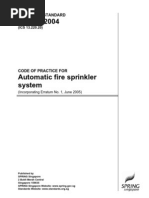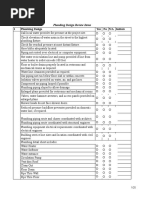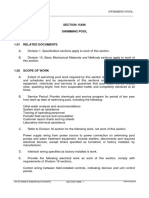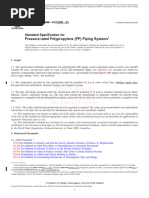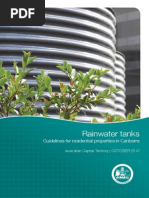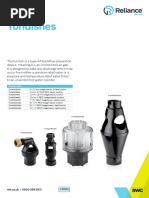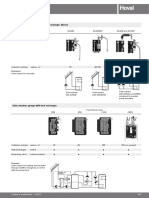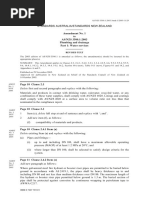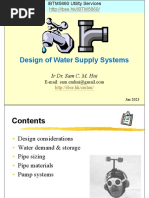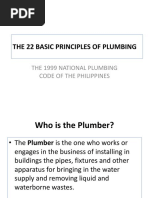Apostila - Rainwater Catchment Systems
Apostila - Rainwater Catchment Systems
Uploaded by
rfmoraes16Copyright:
Available Formats
Apostila - Rainwater Catchment Systems
Apostila - Rainwater Catchment Systems
Uploaded by
rfmoraes16Original Title
Copyright
Available Formats
Share this document
Did you find this document useful?
Is this content inappropriate?
Copyright:
Available Formats
Apostila - Rainwater Catchment Systems
Apostila - Rainwater Catchment Systems
Uploaded by
rfmoraes16Copyright:
Available Formats
ARCSA/ASPE 63: Rainwater
Catchment Systems
First Public Review (December 2012)
This draft has been recommended for public review by the ASPE Main Design Standards
Committee. To submit a comment on this proposed standard, go to the ASPE website at
aspe.org/PublicReview to access the comment form.
2012 American Rainwater Catchment System Association and American Society of Plumbing Engineers. All Rights
Reserved. Permission to reproduce or redistribute all or any part of this document must be obtained from the ASPE
Director of Standards at gpienta@aspe.org.
ARCSA-ASPE_63_Draft3_Approved_for_public_review.docx
Forward
(Informative)
This Rainwater Catchment Design and Installation Standard (hereinafter referred to as the
Standard) has been developed by a joint effort of the American Rainwater Catchment Systems
Association (ARCSA) and the American Society of Plumbing Engineers (ASPE), with
sponsorship support from the International Association of Plumbing and Mechanical Officials.
The purpose of this Standard is to assist engineers, designers, plumbers, builders/developers,
local government, and end users in safely implementing a rainwater catchment system. This
Standard is intended to apply to new rainwater catchment installations, as well as alterations,
additions, maintenance, and repairs to existing installations.
This Standard is intended to be consistent with, and complimentary to, nationally adopted codes
and regulations. However, designers/installers are advised to consult with the plumbing
authority having jurisdiction regarding local conditions, requirements, and restrictions.
ARCSA-ASPE_63_Draft3_Approved_for_public_review.docx
The Standard
(Normative)
1.0
SCOPE
The scope of this Standard covers rainwater catchment systems that utilize the principle of
collecting and using precipitation from a rooftop and other hard, impervious surfaces. This
Standard does not apply to the collection of rainwater from vehicular parking or other similar
surfaces.
1.1
PERFORMANCE OBJECTIVES
1.1.1
1.2
a.
Reduction of risk to consumers from poor design, installation, maintenance, or
illegal work.
b.
Reduction of risk to the public from injury or loss of amenity due to a failure of
the supply, installation, maintenance, or operation of the rainwater catchment
system.
c.
The rainwater catchment system will assist in maintaining and enhancing the
quality of the environment while helping to ensure compliance with the intent of
relevant regulations and government officials.
UNITS OF MEASUREMENT
1.2.1
2.0
The objectives of this Standard are to provide guidance in how to provide and maintain a
healthy alternative to utility-provided water, and to optimize rainwater utilization, while
ensuring:
Values are stated in metric or the International System of Units (SI) with U.S. Customary
Units being referenced parenthetically. The SI units shall be considered as the standard.
REFERENCED STANDARDS
The standards referenced in this section are considered normative either by direct reference in this
Standard or through a general reference of this Section in the Standard:1
2.1
American Society of Mechanical Engineers (ASME)
ASME A 112.6.4-2003: Roof, Deck and Balcony Drains
2.2
American Public Health Association, American Water Works Association, Water Environment
Federation
Standard Methods for the Examination of Water and Wastewater, 22nd Edition
1 Additional standard and guidance document references have been provided in Annex A for informational
purposes.
ARCSA-ASPE_63_Draft3_Approved_for_public_review.docx
2.3
ASTM International
ASTM B32-08: Standard Specification for Solder Metal
ASTM B75/B75M-11: Standard Specifications for Seamless Copper Tube
ASTM B828-02 (2010): Standard Practice for Making Capillary Joints by Soldering of Copper
and Copper Alloy Tube and Fittings
ASTM D1785-12: Standard Specification for Poly(Vinyl Chloride) (PVC) Plastic Pipe, Schedules
40, 80, and 120
ASTM D2241-09: Standard Specification for Poly(Vinyl Chloride) (PVC) Pressure Rated Pipe
(SDR Series)
ASTM D2466-06: Standard Specification for Poly(Vinyl Chloride) (PVC) Plastic Pipe Fittings,
Schedule 40
ASTM D2467-06: Standard Specification for Poly(Vinyl Chloride) (PVC) Plastic Pipe Fittings,
Schedule 80
ASTM D2657-07: Standard Practice for Heat Fusion Joining of Polyolefin Pipe and Fittings
ASTM D2661-11: Standard Specification for Acrylonitrile-Butadiene-Styrene (ABS) Schedule
40 Plastic Drain, Waste, and Vent Pipe and Fittings
ASTM D2665-12: Standard Specification for Poly(Vinyl Chloride) (PVC) Plastic Drain, Waste,
and Vent Pipe and Fittings
ASTM D2855-96 (2010): Standard Practice for Making Solvent-Cemented Joints with
Poly(Vinyl Chloride) (PVC) Pipe and Fittings
ASTM D2949-10: Standard Specification for 3.25-in. Outside Diameter Poly(Vinyl Chloride)
(PVC) Plastic Drain, Waste, and Vent Pipe and Fittings
ASTM D3261-10a: Standard Specification for Butt Heat Fusion Polyethylene (PE) Plastic
Fittings for Polyethylene (PE) Plastic Pipe and Tubing
ASTM D3311-11: Standard Specification for Drain, Waste, and Vent (DWV) Plastic Fittings
Patterns
ASTM D3350-12: Standard Specification for Polyethylene Plastics Pipe and Fittings Materials
ASTM F628-08: Standard Specification for Acrylonitrile-Butadiene-Styrene (ABS) Schedule 40
Plastic Drain, Waste, and Vent Pipe With a Cellular Core
ASTM F714-12e1: Standard Specification for Polyethylene (PE) Plastic Pipe (DR-PR) Based on
Outside Diameter
ASTM F1866-07: Standard Specification for Poly(Vinyl Chloride) (PVC) Plastic Schedule 40
Drainage and DWV Fabricated Fittings
ARCSA-ASPE_63_Draft3_Approved_for_public_review.docx
ASTM F1901-10: Standard Specification for Polyethylene (PE) Pipe and Fittings for Roof Drain
Systems
2.4
American Water Works Association (AWWA)
ANSI/AWWA C110/A21.10-2012: Standard for Ductile-Iron and Gray-Iron Fittings
AWWA C606-2011: Standard for Grooved and Shoulder Joints
2.5
Cast Iron Soil Pipe Institute (CISPI)
CISPI 301-09: Standard Specification for Hubless Cast Iron Soil Pipe and Fittings for Sanitary
and Storm Drain, Waste and Vent Piping Applications
CISPI 310-11: Standard Specification for Couplings for Use in Connection With Hubless Cast
Iron Soil Pipe and Fittings for Sanitary and Storm Drain, Waste, and Vent Piping Applications
2.6
International Organization for Standardization (ISO)
ISO/IEC 17065-2012: Conformity Assessment -- Requirements for Bodies Certifying Products,
Processes and Services
ISO/IEC 17011-2004: Conformity Assessment -- General Requirements for Accreditation Bodies
Accrediting Conformity Assessment Bodies
2.7
NSF International
NSF Protocol P151: Health Effects from Rainwater Catchment System Components
NSF/ANSI Standard 14-2011: Plastic Piping System Components and Related Materials
NSF/ANSI Standard 42-2010: Drinking Water Treatment Units -- Aesthetic Effects
NSF/ANSI Standard 53-2010: Drinking Water Treatment Units -- Health Effects
NSF/ANSI Standard 55-2009: Ultraviolet Microbiological Water Treatment Systems
NSF/ANSI Standard 58-2009: Reverse Osmosis Drinking Water Treatment Systems
NSF/ANSI Standard 60-2011: Drinking Water Treatment Chemicals -- Health Effects
NSF/ANSI Standard 61-2011: Drinking Water System Components -- Health Effects
2.8
U.S. Department of Labor Occupational Safety & Health Administration (OSHA)
Standard 1926: Safety and Health Regulations for Construction, Subpart P, Excavations
ARCSA-ASPE_63_Draft3_Approved_for_public_review.docx
3.0
DESIGN AND INSTALLATION REQUIREMENTS
3.1
Collection Parameters
3.1.1
3.1.2
3.2
a.
Collection roofing, gutters, piping, fittings, valves, screens, downspouts, leaders,
flushing devices, tanks, and liners shall be approved for the intended use.
b.
All tank interior surfaces and equipment shall be washed clean before they are
put into service.
c.
For water storage volumes totaling less than 1,363 liters (360 gallons), or
intended for minor utility, irrigation, and garden use, no treatment is required.
d.
Water level control devices that control pumps, makeup water valves, etc., in
contact with the water supply shall be mercury-free devices.
e.
The system shall be located and maintained to minimize or prevent overhanging
vegetation and airborne pollution from contaminating collected rainwater.
For nonpotable water applications,
a.
The collection surface shall be constructed of aboveground, hard surface,
impervious material.
b.
Harvested rainwater shall be filtered or treated to an appropriate quality suitable
for intended use. No treatment is required for subsurface irrigation or agricultural
use. For above-surface irrigation, the local authority having jurisdiction should be
consulted regarding required water quality.
Conveyance System
3.2.1
3.3
All piping and plumbing system materials and components used in the installation of a
rainwater catchment system shall comply with the applicable referenced standards
specified in Section 2 and be approved for the specific use per local plumbing code, or
be listed by an accredited certification body as available.
The roof drainage system or gutters and downspouts used to collect rainwater shall
comply with the following:
a.
All piping, plumbing components, and material used shall be manufactured of
material approved for the intended application, conforming to the standards
described herein in Section 2.
b.
Gutter and downspout systems leading to the cistern shall be fitted with a debris
excluder or equivalent device.
Pre-filtration
3.3.1
All collected rainwater shall pass through a pre-filtration system before the rainwater
enters the cistern(s).
ARCSA-ASPE_63_Draft3_Approved_for_public_review.docx
a.
The inlet to the pre-filter shall be provided with a debris screen that protects the
cistern from the intrusion of debris, vectors, and vermin. The debris screen shall
be corrosion resistant and shall have openings no larger than a nominal 0.15 cm
(1,500 microns) (1/16 in.).
Exception: Pre-filters with a self-cleaning design are not required to have the
aforementioned debris screen.
b.
If more than one cistern is used, a pre-filtration system shall be provided for each
cistern.
Exception: Where cisterns are interconnected to supply water in series, a single
pre filter is permitted
c.
3.3.2
3.4
Pre-filtration screens or filters shall be readily accessible for regular
maintenance and be maintained consistent with manufacturers specifications.
First flush devices are optionally used to wash accumulated debris from the collection
surface before rainwater is allowed to enter the storage tank. When first flush devices are
used, these systems shall meet the following design requirements:
a.
First flush devices shall be placed after pre-filtration.
b.
Approximate amount of rainfall to be diverted shall be adjustable as necessary to
minimize cistern water contamination. (See Annex B, Acceptable Piping
Schematics, for guidance in determining pre-wash water volume.)
c.
Water drained from the first flush device shall be piped away from the storage
tank and terminate in a location so as not to cause damage to property or cause
erosion.
d.
First flush devices shall be provided with an automatic means of self-draining
between rain events.
e.
First flush devices shall be readily accessible for regular maintenance.
Cisterns / Storage
The following are the minimum requirements for cisterns. Additional requirements are provided
in Section 3.7 for potable water applications.
3.4.1
General
a. Cisterns may be used as rainwater collection points that help to minimize flood
damage, while providing a reservoir for later use. All rigid-bodied cisterns and all
cisterns over 1.22 m (4 ft) in height (rigid or flexible) shall have access to allow
inspection and cleaning.
3.4.2
Installation
a.
Cisterns may be installed either above- or below-grade
ARCSA-ASPE_63_Draft3_Approved_for_public_review.docx
b.
Cisterns shall comply with the administrative authority having jurisdiction, local
building codes and ordinances, and/or as certified by a structural engineer.
c.
Above-grade plastic tanks used as cisterns shall be certified for the intended
application.
d.
Above-grade cisterns shall be protected from direct sunlight and shall:
(1)
Be constructed using opaque, UV-resistant materials (i.e., heavily tinted
flexible or rigid plastic, metal tank with lining, concrete, etc.).
or
(2)
Have specially constructed sun barriers (e.g., installed in garages,
crawlspaces, sheds, etc.).
e.
Below-grade cisterns, located outside of the building, shall be provided with
manhole risers a minimum of 10.2 cm (4 in.) above surrounding grade and/or be
installed in such a way as to prevent surface- or groundwater from entering
through the top of any fittings. Manholes are to be designed to provide sufficient
access into the tank.
f.
Where the installation requires a foundation, the foundation shall be flat and shall
be designed to support the cisterns weight when the cistern is full consistent
with the bearing capability of adjacent soil.
g.
In areas where sustained freezing temperatures occur, provisions shall be made to
keep the cistern and the related piping from freezing.
h.
All cisterns shall be installed in accordance with the manufacturers installation
instructions.
i.
(1)
Underground tanks shall comply with OSHA Standard 1926 Subpart P,
fall protection rules and regulations, and any local codes relating to
excavation and backfill technique or safety.
(2)
Above-grade tanks shall be installed on a sturdy and level foundation or
platform, adequately secured, with adequate drainage consistent with
local codes, ordinances, and seismic regulations.
In a situation where the soil can become saturated, underground tanks shall be
ballasted, or otherwise secured, to prevent the tank from floating out of the
ground when empty. The combined weight of the tank and hold-down ballast
shall meet or exceed the buoyancy force of the tank, calculated as follows:
Example (SI):
For 3,785.4-liter tank, buoyant force will be 3,785.4 liters x (1 cubic foot/28.32
liters) x 62.4 (0.4536 kg/cubic foot) = 3,783.35 kg.
ARCSA-ASPE_63_Draft3_Approved_for_public_review.docx
Buoyancy force of cistern (kg) = 1,000 liters x 28.3 kg/liter = 28,300 kg.
If concrete is used for ballast, the volume needed will be:
Volume (cubic meters) = 28,300 kg x cubic meters/2,400 kg = 11.8 cubic meters.
Example (U.S.):
Buoyant force of cistern (lbs) = Volume (cubic feet) x 62.4 (lbs/cubic foot)
For 1,000-gallon tank, buoyant force will be 1,000 gallons x (1 cubic foot/7.48
gallons) x 62.4 (lbs/cubic foot) = 8,342 lbs.
If concrete is used as ballast, the volume needed will be:
Volume (cubic feet) = 8,342 lbs x cubic feet/150 lbs = 55.6 cubic feet (2.1 cubic
yards).
j.
Cisterns shall be provided with a means for draining and cleaning. Where gravity
drainage is not possible, provision for pumping water from the tank shall be
provided.
k.
All cistern openings shall be protected from unintentional entry by humans or
vermin. Manhole covers shall be provided and shall be secured to prevent
tampering.
(1)
Where an opening is provided that could allow the entry of personnel,
the opening shall be marked,
DANGER -- CONFINED SPACE
3.4.3
Inlets, Outlets, and Openings
a.
Cistern inlets shall be provided to permit water to enter the tank with minimum
turbulence.
b.
The overflow outlet, or flap valve, shall be protected with a screen having
openings no greater than 0.3 cm (0.125 in.), or as otherwise appropriate, for
preventing the entrance of insects or vermin into the cistern.
(1)
Overflow outlet shall be sized in accordance with prevailing gutter and
downspout requirements.
(2)
Water from the cistern overflow shall be discharged in a manner
consistent with local storm water runoff requirements and as approved by
the local authority having jurisdiction, or may be allowed to infiltrate
excess collected water into the ground.
ARCSA-ASPE_63_Draft3_Approved_for_public_review.docx
3.5
PUMP
3.5.1
3.6
Where a pump is provided in conjunction with the rainwater harvesting system, the pump
shall meet the following provisions:
a.
The pump and all other pump components shall be certified and approved for use
with the appropriate potable or nonpotable water systems.
b.
The pump shall be capable of delivering a minimum of 205 kPa (15 psig)
residual pressure at the highest and /or most remote outlet served. Minimum
pump pressure shall allow for friction and other pressure losses. Maximum
pressures shall not exceed 653 kPa (80 psig). A pressure-reducing valve shall be
provided at water branch distribution piping if the pump is capable of exceeding
618 kPa (75 psig).
FILTRATION
Filtration shall meet the following provisions:
3.7
3.6.1
Where rainwater is used for outdoor nonpotable uses and for non-critical operations, such
as irrigation, washdown, etc., a final stage filtration system is not required.
3.6.2
Where rainwater is used for indoor nonpotable use, for laundry, toilets, urinals, process,
etc., the water shall be filtered as a safeguard against sediment or discoloration, and for
proper operation of valves or other devices.
PIPING
3.7.1
There shall be no direct connection of any rainwater harvesting pipe system and a public
utility-provided domestic potable water pipe system without an approved backflow
device.
3.7.2
Separation shall be maintained between potable and nonpotable water systems at all
times. Cross connections, without proper protection in accordance with local applicable
plumbing code, shall not be permitted.
3.7.3
a.
All material used as part of a rainwater harvesting system shall be certified for
the purpose intended, as designated by the local applicable code.
b.
Where rainwater harvesting pipe and potable water pipe are installed in the same
trench, wall cavity, or other location, the potable water pipe shall be separated by
a minimum distance of 30.5 cm (12 in.) above the rainwater harvesting pipe.
Underground pipes shall be installed below the local frost depth.
Piping Materials
a.
Rainwater distribution water piping, fittings, and other related system
components shall be suitable for domestic water application as indicated in the
applicable local building and/or plumbing code, or as otherwise described in
Section 2.
10
ARCSA-ASPE_63_Draft3_Approved_for_public_review.docx
b.
3.7.4
Plastic piping shall be protected from UV radiation by a factory-applied
protective coating, or painted with a compatible latex paint. Piping and solvent
cements shall be approved for the intended use.
Labeling
If a rainwater harvesting system is applied to any building, facility, or residence, it shall
be so indicated as follows:
a.
All rainwater-supplied fixtures, not specifically treated for potable water use,
shall be prominently labeled:
NONPOTABLE -- DO NOT DRINK.
b.
Nonpotable water piping shall be designated by colored bands and solid color
piping as specified by the authority having jurisdiction or national code agencies,
and labeled:
NONPOTABLE -- RAINWATER.
c.
3.7.5
Outlets and fixtures served with harvested rainwater shall be easily recognizable
by color or a symbol for nonpotable water.
Inspections
Rainwater harvesting systems are considered a private water system under the
responsibility of the building owner/operator, and shall be minimally inspected according
to the following schedule:
a.
Inspection of all elements before they are covered (rough-in inspection).
b.
Final inspection, including testing.
c.
In addition to testing required by the code for plumbing systems, the following
also apply:
d.
3.7.6
(1)
Testing and commissioning.
(2)
Piping. A flow test shall be performed through the system to the point of
water distribution and disposal. In addition, the water distribution system
shall be tested and proved tight at the operating pressure. Where the
manufacturer permits, a 446 kPa (50 psi) hydrostatic test may substitute
for the test above. All lines and components shall be watertight.
Other inspections as needed to ensure proper system operation.
System Maintenance
It is the property owners responsibility to maintain the system components according to
manufacturers written recommendations.
11
ARCSA-ASPE_63_Draft3_Approved_for_public_review.docx
3.7.7
Rainwater harvesting systems shall be maintained in functioning order for the life of the
system.
a.
Filtration and disinfection systems shall be serviced in accordance with
manufacturers recommendations.
b.
System Abandonment
If the owner of a rainwater harvesting system elects to cease use of, or fails to
properly maintain such system, the owner shall abandon the system. To abandon
the system, the system owner shall minimally:
(1) Remove or disable all system connecting piping to utility-provided water
system.
(2) Replace the rainwater harvesting pipe system with an approved potable water
supply pipe system. Where an existing potable pipe system is already in
place, fixtures may be re-connected to the existing system.
(3) Secure cistern from accidental access by sealing or locking tank inlets and
access points, and/or filling with sand or equivalent.
3.8
POTABLE RAINWATER APPLICATIONS
3.8.1
3.8.2
Collection surfaces for potable water applications shall made of non-toxic material and
meet the requirements noted in 3.1.1 above.
a.
Painted surfaces are only acceptable if paint has been certified to ensure the
toxicity level of the paint is acceptable for drinking water contact. Lead,
chromium or zinc based paints are not permitted.
b.
Enameled steel.
c.
Flat Roofs: Roof products shall be certified to NSF Protocol P151.
d.
Collection of water from vehicular parking surfaces is prohibited.
The following materials shall not be used in potable water applications2:
a.
Wood /cedar shake roofing.
b.
Copper roofing materials.
c.
Lead flashing.
2 The use of bitumen/composition roofing or galvanized, zinc-coated metal is not recommended and should be used
with caution.
12
ARCSA-ASPE_63_Draft3_Approved_for_public_review.docx
3.8.3
Cisterns
3.8.4
3.8.5
a.
Water entering the cistern shall be maintained at a quiescent flow in the cistern
by minimizing splashing and disturbance of sediment in bottom of cistern.
b.
For potable water applications, and recommended for maintaining good water
quality, the pipe entering the cistern shall terminate in a return bend elbow
pointed upward at the bottom of the tank, or equivalent calming device.
c.
Cistern outlets shall be provided with floating inlet to draw water from the cistern
just below the water surface, or the outlet shall be located at least 10 cm (4 in.)
above the bottom of the cistern.
d.
Cisterns shall be certified to NSF/ANSI Standard 61. Plastic tanks shall adhere to
the requirements of NSF/ANSI Standard 61 and be constructed of virgin plastic.
e.
Cisterns shall not be connected directly to a public or community water supply
without approved backflow protection. Make-up water to rainwater storage tanks,
when provided, may be made through a reverse pressure principle backflow
device or an air gap per local plumbing codes.
f.
If installed below-grade, cisterns shall be separated from sanitary waste piping a
distance as recommended by local authority having jurisdiction or local plumbing
codes and up gradient from septic field piping where applicable.
Filtration
a.
Carbon filtration may be provided for reduction of taste, odor, and organic
chemicals.
b.
Filtration and disinfection systems shall be located after water storage tank and as
close to the final point of use as possible.
c.
All particulate filtration shall be installed upstream of disinfection systems.
d.
Filters shall be adequately sized to extend service time and must be comply with
NSF/ANSI Standard 53.
Water Disinfection
a.
Chlorination may be used with an automated demand feed system, and if used,
shall enable adequate contact time and residual according to local health
authorities.
b.
Ozone may be used with an approved ozone system ensuring adequate contact
time with the ozone. Provision must be made to off- gas ozone to a safe
environment.
c.
Ultraviolet disinfection may be used and shall be provided between final
filtration (5 micron maximum) and final point of use. UV systems shall be
certified to NSF/ANSI Standard 55.
13
ARCSA-ASPE_63_Draft3_Approved_for_public_review.docx
3.9
Operation and Maintenance
3.9.1
Prior to Use
Prior to system operation, all debris will be removed from the collection surface and
piping system. The cistern and distribution piping shall be cleaned with a sanitizing
solution.
a.
After several cycles of rainwater harvesting, an initial sample of the resultant
accumulated water shall be tested for compliance according to the procedures
listed in the latest edition of Standard Methods for the Examination of Water and
Wastewater. Systems that cannot meet the minimum quality standards as listed in
Table 3.1 shall be re-cleaned and then tested again, after several additional rain
events, for compliance with the applicable standards. Should the water quality
still not be achievable, the system shall be provided with an appropriate
filtration/disinfection device noted in Sections 3.8.4 and 3.8.5.
b.
For private water systems, prior to placing the water system into service, water
quality testing, at a minimum, shall be performed for E. coli, total coliform, and
heterotrophic bacteria using the minimum quality standards provided in Table
3.1.
c.
Public System
(1)
In addition 3.9.1(a) and (b), water shall be tested for Cryptosporidium.
(2)
Subsequent annual tests shall be made for total coliform, E. coli,
heterotrophic bacteria, and any chemicals of concern.
(3)
Records of test results shall be maintained for at least two years.
Table 3.1 STORED RAINWATER MINIMUM QUALITY STANDARDS
INTENDED END USE QUALITY LEVEL
NONPOTABLE
POTABLE 1
Escherichia coli (E. coli)
< 100 CFU / 100 ml
99.9999% Reduction
Protozoan Cysts
< 10 NTU
99.9% Reduction
Viruses
-----------------
99.99% Reduction
PARAMETER
Turbidity
< 0.3 NTU
Potable water standard meets the United States Environmental Protection Agency (US EPA)
drinking water standard for pathogens.
Note: Monitoring requirements vary greatly from state to state. Consult state and local guidelines for
monitoring requirements.
14
ARCSA-ASPE_63_Draft3_Approved_for_public_review.docx
3.9.2
Water Quality Maintenance
a.
The quality of the water for the intended application shall be verified at the point
of use in accordance with the minimum requirements of Table 3.1 complying
with the testing procedures set forth in the Standard Methods for the Examination
of Water and Wastewater.
b.
Nonpotable water shall be tested every 12 months. Potable water shall be tested
every three months.
c.
For a potable public water system, one sample shall be analyzed for applications
serving up to 1,000 persons. When the treated water shall serve 1,0002,500
persons, two samples shall be analyzed, and for 2,501 persons and up, three
samples shall be analyzed. Samples must come from the following locations
when additional taps for sampling are available:
(1) One sample from the same location as the positive sample;
(2) One sample within five service connections upstream;
(3) One sample within five service connections downstream; and
(4) For systems serving 251,000 persons, a fourth sample from any other
sampling site.
d.
4.0
If the quality of the tested water cannot consistently be maintained at the
minimum levels specified in Table 3.1, the system shall be equipped with an
appropriate treatment device meeting the applicable NSF/ANSI Standard
referenced in Section 2.
DEFINITIONS
The following terms are defined in the manner in which they are intended to be used in the Standard.
Additional definitions of terms relevant to the scope of this standard that are not used in the body of the
Standard are provided in Annex C for informational purposes.
4.1
ACCREDITED: Verification that a certification body meets the requirements of ISO/IEC 17065
by a third-party agency operating in compliance with ISO/IEC 17011.
4.2
CERTIFIED: Verified compliance to a standard by a certification body that has been accredited
by third-party as having systems in compliance with ISO/IEC 17065.
4.3
CISTERN: The central storage component of the rainwater harvesting system. Also referred to as
a storage tank.
4.4
CODE: Refers to the local written authority.
4.5
DEBRIS EXCLUDER: A screen or other device installed on the gutter or downspout system to
prevent the accumulation of leaves, needles, or other debris in the system.
15
ARCSA-ASPE_63_Draft3_Approved_for_public_review.docx
4.6
DISINFECTION: Reduction of viable microorganisms to a level that is deemed suitable for the
intended application. Typical units of measure are colony forming units per deca-liter (cfu/dl).
4.7
FILTRATION: Physical removal of liquid-borne contaminants by means of separation from the
output flow.
4.7.1 PARTICULATE FILTRATION: Removal of suspended particles (measured in units of
total suspended solids (TSS).
4.7.2 CARBON/ABSORPTION FILTRATION: Removal of dissolved compounds measured in
units of total dissolved solids (TDS).
4.8
GROUNDWATER: Water that has saturated into the ground and no longer flows across the
surface.
4.9
FLAT: Having a slope no greater than 1 in 50.
4.10
PIPING SYSTEM: Pipes and components that convey the harvested rainwater and distribute it to
various fixtures.
4.11
POINT OF USE: A point in a domestic water system, nearest to a water-consuming plumbing
fixture, where water is used.
4.12
PRECIPITATION: Water that has precipitated from the atmosphere (e.g., rain, snow, mist, dew).
4.13
PRIVATE WATER SYSTEM: System used by less than 25 persons over a 60-day period, or
contain less than 15 plumbing fixtures.
4.14
PROCESS WATER: Water to be used for household and commercial applications.
4.15
PUBLIC SYSTEM: System used by 25 persons or more over a 60-day period, or contain 15
plumbing fixtures or more.
4.16
QUIESCENT INFLOW: Routing of rainwater into rainwater reservoirs so that the existing
sediment is not activated in the rainwater reservoir and an immediate sedimentation of solids is
possible.
4.17
RAINWATER: Water from natural precipitation that is not contaminated by use.
4.18
RAINWATER HARVESTING SYSTEM: Water system for utilizing rainwater, consisting of a
cistern(s), pipe, fittings, pumps, and/or other plumbing appurtenances, required for and/or used to
harvest and distribute rainwater. Also called rainwater catchment system.
4.19
RETURN BEND ELBOW: A section of pipe with a 180-degree bend.
4.20
ROOF DRAINAGE SYSTEM: A system, comprised of roof drains, overflow drains, scuppers,
gutters, and downspouts, used to convey the rainwater from the roof surface to the roof washer
and the cistern.
4.21
ROOF SURFACE: The surface rainwater harvesting systems rely on for the collection of
rainwater that has fallen on a building roof.
16
ARCSA-ASPE_63_Draft3_Approved_for_public_review.docx
4.22
ROOF WASH OR ROOF WASHER: A device or method for removal of sediment and debris
from the collection surface by diverting initial rainfall from entry into the cistern(s). Also called a
first flush device.
4.23
SCREEN: A filtration device, constructed of corrosion-resistant wire or other approved mesh,
having openings in determined sizes.
4.24
SEDIMENTATION: Separation of solids from the water via gravity.
4.25
SLOPE OR SLOPING: Having a slope greater than 1 in 50.
4.26
STORM WATER: Natural precipitation that has contacted a surface at grade or below-grade and
has not been put to beneficial use.
4.27
STORM WATER CATCHMENT SYSTEM: A system that collects and stores storm water for
beneficial use.
4.28
SUCTION LINE: Water pump inlet piping.
4.29
SUN BARRIERS: A cover, or erected structure, specifically to shelter a cistern from the direct
rays of the sun.
4.30
SURFACE IRRIGATION: Water that is applied above ground level and is directly exposed to
the aboveground surface and/or air.
4.31
SUBSURFACE IRRIGATION:
topsoil.
4.32
SURFACE WATER: Rainwater that touches the ground and flows across the surface of the
ground (landscapes, driveways, roadway, parking surface, gully, creeks, streams etc.).
Irrigation system installed below finished grade within the
End of Normative Standard
17
ARCSA-ASPE_63_Draft3_Approved_for_public_review.docx
Annex A
Additional Relevant Standards/Documents
(Informative)
1.
ASTM International
ASTM D638-10: Standard Test Method for Tensile Properties of Plastics
ASTM D695-10: Standard Test Method for Compressive Properties of Rigid Plastics
ASTM D1599-99(2011): Standard Test Method for Resistance to Short-Time Hydraulic Pressure
of Plastic Pipe, Tubing, and Fittings
ASTM D1600-08: Standard Terminology for Abbreviated Terms Relating to Plastics
ASTM E84-12b: Standard Test Method for Surface Burning Characteristics of Building Materials
ASTM F412-12: Standard Terminology Relating to Plastic Piping Systems
2.
International Association of Plumbing and Mechanical Officials (IAPMO)
Uniform Plumbing Code
Green Plumbing and Mechanical Code Supplement
3.
International Code Council (ICC)
International Plumbing Code
International Green Construction Code
4.
International Organization for Standardization (ISO)
ISO 899-1 (2003): Plastics -- Determination of Creep Behavior
5.
National Weather Service (NWS)
NWS HYDRO-35: Five to 60-Minute Precipitation Frequency for the Eastern and Central United
States
6.
National Oceanic and Atmospheric Administration (NOAA)
National Climate Data Center
http://www.ncdc.noaa.gov/
NOAAs National Climatic Data Center Climate Normals 19812010
7.
Plumbing-Heating-Cooling Contractors Association (PHCC)
National Standard Plumbing Code
End of Annex A
18
ARCSA-ASPE_63_Draft3_Approved_for_public_review.docx
Annex B
Acceptable Piping Schematics
(Informative)
Figure 1: Aboveground Exterior Cistern for Potable and/or Nonpotable Water
Figure shows an aboveground application in a non-freeze environment. In an environment where
freezing is possible, the tank should be located in a heated environment, buried below the frost line, as
shown in Figures 2 and 3, or otherwise heated or winterized to accommodate freezing conditions without
system damage.
19
ARCSA-ASPE_63_Draft3_Approved_for_public_review.docx
Figure 2: Underground Exterior Cistern for Potable Application
Where carbon filters are used, they may be put downstream of chlorine and ozone disinfection systems,
but are recommended to be upstream of ultraviolet disinfection systems. Where soil saturation is a
possibility, it is recommended that the combined weight of the tank and ballast must meet or exceed the
buoyancy upward force of an empty cistern. This buoyancy force (lbs) is equal to the volume of the tank
(cubic feet) x 62.4 lbs /cubic feet, or tank volume (gallons) x 8.34 lbs /gallon water.
20
ARCSA-ASPE_63_Draft3_Approved_for_public_review.docx
Figure 3: Underground Exterior Cistern for Nonpotable Water
This application is suitable for indoor toilet and urinal flushing, lawn and plant irrigation, or process water
makeup. Filters to remove particulates may be added to improve water quality or to avoid problems with
sprinkler or process devices. Signage marking water outlets as Nonpotable -- Do Not Drink is required
in a public environment and highly recommended elsewhere.
21
ARCSA-ASPE_63_Draft3_Approved_for_public_review.docx
Figure 4: Aboveground Interior Cistern for Potable and Nonpotable Water
Installing a water storage tank in a heated environment is preferred for an installation subject to freezing.
Appropriate signage is necessary to label nonpotable water outlets.
First Flush Devices
To supplement the pre-filtration of water entering the cistern, first flush devices are commonly used to
divert the initial water coming off the collection surface before being allowed to fill the cistern. Although
first flush devices are not required in many cases, they are recommended in the following cases:
1. Systems installed in areas that historically have long periods of time between rainstorms where
fine debris and contaminants can accumulate over time.
2. Potable rainwater applications.
Commonly used roof wash amounts are indicated in Figure 5, but may be varied to reflect actual site and
seasonal conditions.
Figure 5: Estimated Roof Contamination Potential
High Contamination 1
5.0 mm (0.20 in.)
22
Medium Contamination
2.0 mm (0.08 in.)
Low Contamination2
0.5mm (0.02 in.)
ARCSA-ASPE_63_Draft3_Approved_for_public_review.docx
There are many different styles of roof wash devices. The simplest versions involve filling a standpipe
section of piping that contains adequate volume, that once full, then overflows into the cistern. (See Figure
6.)
23
ARCSA-ASPE_63_Draft3_Approved_for_public_review.docx
The volume of pre-wash for a nominal 4 in. (4.046 in. actual) diameter PVC pipe can be determined as
follows in Figure 7a.
Figure 7a. 4 in. PVC Pipe Storage Volume
Length : feet (meters)
Volume: liters (gallons)
1 (0.3)
2.6 (0.7)
3 (0.9)
7.6 (2.0)
5 (4.6)
12.5 (3.3)
10 (3.0)
25.4 (6.7)
15 (4.6)
38.1 (10.5)
The volume of pre-wash for a nominal 6 in. (6.065 in. actual) diameter PVC pipe can be seen in Figure 7b.
Length : feet (meters)
1 (.3)
Figure 7.b 6" PVC Pipe Storage Volume
Volume: liters (gallons)
5.7 (1.5)
3 (.9)
17.0 (4.5)
5 (4.6)
28.4 (7.5)
10 (3.0)
56.8 (15.0)
15 (4.6)
85.2 (22.5)
End of Annex B
24
ARCSA-ASPE_63_Draft3_Approved_for_public_review.docx
Annex C
Reference Definitions
(Informative)
The following terms are commonly used in the rainwater catchment system industry, and the definitions
are provided for informational purposes.
AUXILIARY SUPPLY: A water supply arranged and protected from contamination that is available to
provide an alternate means of filling a cistern.
CALMING INLET: A device that permits water to enter a storage tank with minimal disturbance to
particles that may have settled to the bottom of the tank. See Quiescent Flow.
COLLECTION AREA: Area from which rainwater is collected for use in a rainwater harvesting system
(e.g. roof area).
DRY RUN PROTECTION: System for protecting the water pump against running dry.
EVAPORATION FIELD: Element in the ground that is filled with gravel, ballast, or special nonpermeable plastic elements and that stores rainwater that is fed into it on an intermediate basis before the
water evaporates into the atmosphere or seeps into the surrounding soil.
FIRE SPRINKLER RESERVE: Volume of water needed for fire protection that is not available for any
other use and accessible only by the fire pump.
HARVESTED WATER: Water gathered for the purpose of using for potable, nonpotable, or industrial
applications.
LEACH FIELD, EVAPORATION/TRANSPIRATION FIELD: Element in the ground that is filled with
gravel, ballast, or special permeable plastic elements and that stores rainwater that is fed into it on an
intermediate basis before the water seeps into the surrounding soil.
MINIMUM WATER VOLUME: Recoverable water volume that is constrained by the process such that
neither sediment nor scum can be sucked into the deliverable water.
OVERFLOW LEVEL: The highest level that water from a drainage system can rise.
OVERFLOW LINE: Line for leading away rainwater when the rainwater reservoir is full (e.g., into the
storm drain system or seepage system).
PRECIPITATION CHARACTERISTICS:
duration).
Characteristics of a precipitation event (e.g., intensity,
PROCESS WATER LINE: System of lines from the process water pump to the individual points at which
water is drawn.
PROCESS WATER PUMP: Pumps process water from the rainwater reservoir to the points at which it is
drawn.
25
ARCSA-ASPE_63_Draft3_Approved_for_public_review.docx
PROCESS WATER REQUIREMENTS: Planning value for the process water amount that is expected to
be required in a specified period of time.
PUBLIC WATER SYSTEM: System that is used by 25 or more different persons over a 60-day period.
QUANTITY OF PRECIPITATION: Precipitation at a certain place, expressed as the water height over a
horizontal area for a span of time under consideration.
RAINWATER LINE: Supply, drainage, overflow, and emptying lines of a rainwater harvesting system.
RAINWATER YIELD: Net water volume (water inflow), determined over a certain period of time,
available for use as process water. Typically this is approximately 80% of theoretical collectable rainwater.
SUBSURFACE IRRIGATION: Water that is applied below ground level, and is not directly exposed to
the aboveground surface and/or surrounding air.
SUPPLEMENTAL SUPPLY: Equipment for providing a supplemental supply of drinking water or nondrinking water into process water systems.
SYSTEM CONTROL UNIT: Control unit for the automatic operation of the rainwater harvesting system.
TRANSFER PUMP: A mechanical device to transfer collected water from downspouts to remote cisterns.
USEFUL VOLUME: Volume that can be completely used during operation (Typically 8090% of storage
volume).
YIELD COEFFICIENT: Ratio of the rainwater annually flowing into the rainwater harvesting system to
the total amount of rainwater in the accompanying precipitation area , allowing for leakage, splashing,
evaporation, etc. (typically 0.750.90).
End of Annex C
26
ARCSA-ASPE_63_Draft3_Approved_for_public_review.docx
Annex D
Example of a Maintenance Form
(Informative)
End of Annex D
27
ARCSA-ASPE_63_Draft3_Approved_for_public_review.docx
Annex E
Calculation Procedure
(Informative)
Step 1: Estimate demand
Interior Water Requirement*: On average, a conserving American household uses 45.2 gallons per
person/day to operate toilets, showers, clothes washers, sinks, and other water -using fixtures and
appliances. Water demand can be minimized by using water efficient water fixtures. An example of how
to estimate water demand is shown as follows:
Fixture
Flow
Rate
(liters
per
use or
min)
**
6.0
Residential Indoor Water Use (Metric)
Average
Household
#
Daily
Total
Number of
uses/day
Demand/
Daily
people in
or
person
Demand/
household
min/day
( L)
( L)
per
person
5.1
30.89
3
92.67
Toilets
Shower
(liters /
minute)
6.3
5.3
33.31
Faucets
(liters /
minute)
6.3
8.1
50.91
Dishwasher
(19972001)
(liters/use)
17.0
0.1
1.70
Clothes
washer
(1998 2001)
(liters/use)
102.2
0.37
37.82
Total
Demand
*Source: "Handbook of Water Use and Conservation"
MA, ISBN I-931579-07-5
** Actual Flow (MFR)
28
Household
Total
Monthly
demand
( L)
Household
Total
Yearly
demand
( L)
2,809
33,823
99.90
3,028
36,469
152.70
4,626
55,733
5.11
155
1,866
113.45
3,437
41,409
463.83
14,055
169,300
Amy Vickers, 2001, Waterplow Press, Amherst,
ARCSA-ASPE_63_Draft3_Approved_for_public_review.docx
Residential Indoor Water Use (English)
Fixture
Toilets
Shower
(based on 2.5
gal/min)
Faucets (based
on 2.5
gal/min)
Dishwasher
(1997- 2001)
(gal/use)
Clothes
washer (1998
- 2001)
(gal/use)
24.48
Household
Total
Monthly
demand
(gal)
742
Household
Total
Yearly
demand
(gal)
8,935
26.39
800
9,634
13.45
40.34
1,222
14,723
0.1
0.45
1.35
41
493
0.37
9.99
29.97
908
10,939
122.5
3,713
44,724
Flow
Rate (per
use or
min) **
Average #
uses/day or
min/day
per person
Daily
Demand/
person
(gal)
Number of
people in
household
Household
Total Daily
Demand/
(gal)
1.6
5.1
8.16
1.66
5.3
8.80
1.66
8.1
4.5
27
Total
Demand
*Source: "Handbook of Water Use and Conservation" Amy Vickers, 2001, Waterplow Press, Amherst, MA, ISBN I931579-07-5
** Actual Flow (MFR)
Irrigation Water Requirement: Water used to irrigate landscaping often equals or exceeds interior water
use. Supplemental irrigation water requirements can be greatly reduced by the use of 3 in. or more of top
mulch, selecting native plants or plants that thrive in regions with similar climate, and using passive
rainwater techniques. Because plant water needs vary greatly depending on soils, climate, plant size, etc. it
is recommended that a calculator for your region be referenced. For calculators, visit the ARCSA website
at www.arcsa.org.
Step 2: Sizing the Collection System
The collection surface is often dictated by architectural constraints, such as roof area, etc. The amount of
surface area, based on the needed water volume, is described as follows:
Surface Area (Square Feet) = Demand (Gallons) / 0.623 x Precipitation Density (inches) x system
efficiency
Note:
0.623 (gallons / square foot / inch) conversion factor = 7.48 (gallons / cubic foot) / 12 (inches per
foot). 1 inch of water covering 1 square foot of surface area = 2.358 L (0.623 gallons).
Surface area is horizontal projection of roof surface and not actual surface area (measure the area
the roof covers, not the actual roof).
29
ARCSA-ASPE_63_Draft3_Approved_for_public_review.docx
Precipitation density period is consistent with time period being considered (monthly, yearly, etc.).
This coefficient accounts for collection system loss from leakage, evaporation, roof composition,
etc. Roof coefficients are approximately 0.800.85.
Step 3: Sizing the Storage
(Adapted from Martin, T.J. (1980). Supply aspects of domestic rainwater tanks. South Australian
Department of Environment, Adelaide.)
Once the area of roof catchment has been determined and the average rainfall has been established, the
maximum amount of rain that can be collected can be calculated using the formula:
Runoff (Gallons) = A x (Rainfall B) x Roof Area
Where:
A is the efficiency of collection, and values of 0.800.85 (i.e., 8085% efficiency) have been used.
B is the loss associated with adsorption and wetting of surfaces, and a value of 0.08 in. per month (2.0 in.
per year) has been used (e.g. Martin, 1980).
Rainfall should be expressed in inches and roof area in square feet.
The maximum volumes of rainwater that can be collected from various areas of roof and at a range of
average annual rainfalls are shown in Annex F. This information should only be used as an initial guide. If
the maximum volumes are less than the annual water demand then either the catchment area will need to
be increased or water demand will need to be reduced.
The next step is to calculate the size of the tank. The tank needs to be large enough to ensure that:
1. The required volume of water can be collected and stored in the tank.
2. The volume of water in the tank will be sufficient to meet demand during the drier months or through
periods of low or no rainfall.
The simplest way of checking a tank size estimated to provide water throughout an average year is to use
monthly rainfall data and to assume that at the start of the wetter months the tank is empty. The following
formula should then be used for each month:
Vt = Vt1 + (Runoff Demand)
Where:
Vt is the theoretical volume of water remaining in the tank at the end of the month.
Vt1 is the volume of water left in the tank from the previous month.
Runoff should be calculated as discussed above (A = 0.80, B = 0.08 in.).
Starting with the tank empty then Vt1 = 0. If after any month Vt exceeds the volume of the tank, then
water will be lost to overflow. If Vt is ever a negative figure, then demand exceeds the available water.
Providing the calculated annual runoff exceeds the annual water demand, Vt will only be negative if
periodical overflows reduce the amount of water collected so that it is less than the demand.
30
ARCSA-ASPE_63_Draft3_Approved_for_public_review.docx
Tank size is not necessarily based on collecting total roof runoff. For example, the maximum water that
can be collected from a roof area of 20 square feet with a monthly rainfall of 4 in. will be about 40 gallons.
If the water demand is less than this, some overflow may occur while demand is still met. If water demand
is to be met throughout the month, the tank should be large enough so that Vt is never negative.
Calculations should be repeated using various tank sizes until Vt is 0 at the end of every month. The
greater the values of Vt over the whole year, the greater the security of meeting water demand when
rainfalls are below average or when dry periods are longer than normal.
The greater the security, the higher the cost of the tank.
Step 4: System Adjustment
To optimize performance and cost, going back through the calculation and modifying surface area and the
cistern storage capacity is recommended.
End of Annex E
31
ARCSA-ASPE_63_Draft3_Approved_for_public_review.docx
Annex F
Average Rainfall Data (Informational)
32
ARCSA-ASPE_63_Draft3_Approved_for_public_review.docx
33
ARCSA-ASPE_63_Draft3_Approved_for_public_review.docx
34
ARCSA-ASPE_63_Draft3_Approved_for_public_review.docx
35
ARCSA-ASPE_63_Draft3_Approved_for_public_review.docx
36
ARCSA-ASPE_63_Draft3_Approved_for_public_review.docx
37
ARCSA-ASPE_63_Draft3_Approved_for_public_review.docx
38
ARCSA-ASPE_63_Draft3_Approved_for_public_review.docx
39
ARCSA-ASPE_63_Draft3_Approved_for_public_review.docx
40
ARCSA-ASPE_63_Draft3_Approved_for_public_review.docx
41
ARCSA-ASPE_63_Draft3_Approved_for_public_review.docx
42
ARCSA-ASPE_63_Draft3_Approved_for_public_review.docx
43
You might also like
- 100 Dynamic Quizzes For Plumbing EngineersDocument33 pages100 Dynamic Quizzes For Plumbing Engineerszubairniyazi786100% (1)
- Singapore CP 52 2004+err1Document9 pagesSingapore CP 52 2004+err1SuSi Aothunthoitrang25% (4)
- Guidelines for Engineering Design for Process SafetyFrom EverandGuidelines for Engineering Design for Process SafetyRating: 5 out of 5 stars5/5 (2)
- Plumbing Design ChecklistsDocument25 pagesPlumbing Design ChecklistsParwez Khan67% (3)
- Technical Solution Sheet 99.02: Rainwater TanksDocument8 pagesTechnical Solution Sheet 99.02: Rainwater TanksBarrasons Engineers TeamNo ratings yet
- A112 Standards DescriptionDocument6 pagesA112 Standards Descriptionsmupy_122No ratings yet
- 10 States Standards - Recommended Standards For Wastewater FacilitiesDocument116 pages10 States Standards - Recommended Standards For Wastewater FacilitiesÁrpád VassNo ratings yet
- Public Health Water Systems Design WSDocument28 pagesPublic Health Water Systems Design WSRamadan EssaNo ratings yet
- Rainwater Standard DraftDocument42 pagesRainwater Standard Draftabdulwadood_engineerNo ratings yet
- SECTION 22 67 19.16 Reverse-Osmosis Water EquipmentDocument10 pagesSECTION 22 67 19.16 Reverse-Osmosis Water EquipmentTuesou MachereNo ratings yet
- Plumbing Works Technology-1Document32 pagesPlumbing Works Technology-1neilNo ratings yet
- Intro To Wastewater Collection and PumpingDocument84 pagesIntro To Wastewater Collection and PumpingMoh'd KhadNo ratings yet
- SAV4623Document32 pagesSAV4623andreasbkusumaNo ratings yet
- Technical Instruction For Water Supply SystemDocument9 pagesTechnical Instruction For Water Supply SystemToviwaNo ratings yet
- 10 State Standards - Waste Water FacilitiesDocument178 pages10 State Standards - Waste Water Facilitiesblin254No ratings yet
- Corrosion Protection Ferrous Water 021204Document4 pagesCorrosion Protection Ferrous Water 021204ogobadogoNo ratings yet
- Technical Guide Wavin PVC Pressure Pipe SystemsDocument50 pagesTechnical Guide Wavin PVC Pressure Pipe SystemsUmair Suhail100% (2)
- 08-Section 2-Section 02210 HDPE Pipeline-Version 2.0Document20 pages08-Section 2-Section 02210 HDPE Pipeline-Version 2.0Avaan IvaanNo ratings yet
- Handbook On Plumbing Installation For BuildingsDocument86 pagesHandbook On Plumbing Installation For BuildingsKurnia ZulianaNo ratings yet
- Spec Pe Pipe Tubing Fittings WaterDocument12 pagesSpec Pe Pipe Tubing Fittings WatersabahiraqNo ratings yet
- Saes S 010Document19 pagesSaes S 010Cherukunnon Jubu100% (1)
- Part E - 5 - Public Health - Water Systems Design (WS)Document57 pagesPart E - 5 - Public Health - Water Systems Design (WS)abinradhNo ratings yet
- Florida BLDG Code Appendix FDocument17 pagesFlorida BLDG Code Appendix FSarah GlennNo ratings yet
- Rubber Gasket TypesDocument92 pagesRubber Gasket Typessushant_moreyNo ratings yet
- ASPE 45 Siphonic Roof DrainageDocument45 pagesASPE 45 Siphonic Roof Drainagesamet.carikcimuhendislikNo ratings yet
- Mechanical SpecificationDocument13 pagesMechanical SpecificationAhmad AyyoubNo ratings yet
- HBon PIBDocument72 pagesHBon PIBعرفه نصرNo ratings yet
- Water SystemDocument612 pagesWater SystemmohdnazirNo ratings yet
- Normas Empleadas en La Industrias de Tuberia Plastica PDFDocument54 pagesNormas Empleadas en La Industrias de Tuberia Plastica PDFcalidad1340No ratings yet
- 62-555.320 Design and Construction of Public Water SystemsDocument11 pages62-555.320 Design and Construction of Public Water SystemstestNo ratings yet
- An Intro To Med Plumb & GasDocument45 pagesAn Intro To Med Plumb & Gasangel darioNo ratings yet
- Report Sanitary Plumbing Drainage and Pipe SizingDocument30 pagesReport Sanitary Plumbing Drainage and Pipe SizingcodefinderNo ratings yet
- BCD Presentation CPVC Pipe TubingDocument108 pagesBCD Presentation CPVC Pipe TubingMohammed Mostafa El HaddadNo ratings yet
- Hydraulic Transients in Service LinesDocument6 pagesHydraulic Transients in Service Linestsegabirhan haileslassieNo ratings yet
- RG 195 PDFDocument140 pagesRG 195 PDFx raysNo ratings yet
- Handbook On Plumbing Installation For BuildingDocument107 pagesHandbook On Plumbing Installation For BuildingKhristine CloribelNo ratings yet
- Module1 Stress ObjectiveDocument48 pagesModule1 Stress ObjectivepalluraviNo ratings yet
- Guidelines For Pipe Bursting of Potable Water MainsDocument17 pagesGuidelines For Pipe Bursting of Potable Water MainsgitanodefeNo ratings yet
- Section 15400 - Plumbing Fixtures and EquipmentDocument4 pagesSection 15400 - Plumbing Fixtures and EquipmentAnonymous NMytbMiDNo ratings yet
- 02810Document8 pages02810uddinnadeemNo ratings yet
- Astm F2389 23Document7 pagesAstm F2389 23S. Qamar Abbas NaqviNo ratings yet
- SAES-L-310 (Design of Plant Piping)Document30 pagesSAES-L-310 (Design of Plant Piping)Cherukunnon Jubu100% (5)
- 16 15C7 FiltersDocument5 pages16 15C7 FiltersmanikantanNo ratings yet
- Depot Water System Design ReportsDocument19 pagesDepot Water System Design ReportsMuhammad Ashraful ArifinNo ratings yet
- 22 40 00 - Plumbing FixturesDocument22 pages22 40 00 - Plumbing Fixturesmd zubairNo ratings yet
- CODES and STANDARDS PDFDocument10 pagesCODES and STANDARDS PDFemnptn2667No ratings yet
- Standard Specification For Pressure Rated Polypropylene PP Piping Systems 3Document1 pageStandard Specification For Pressure Rated Polypropylene PP Piping Systems 3S. Qamar Abbas NaqviNo ratings yet
- Atv A 257 eDocument8 pagesAtv A 257 eLaurentiu GheorghitaNo ratings yet
- Concrete Pipes and Portal Culverts HandbookDocument52 pagesConcrete Pipes and Portal Culverts HandbookKenya Ayallew Asmare100% (3)
- A Guide to Sanitation Safety Planning in the Philippines: Step-By-Step Risk Management for Safe Reuse and Disposal of Wastewater, Greywater, and ExcretaFrom EverandA Guide to Sanitation Safety Planning in the Philippines: Step-By-Step Risk Management for Safe Reuse and Disposal of Wastewater, Greywater, and ExcretaNo ratings yet
- Design of Wastewater and Stormwater Pumping Stations MOP FD-4, 3rd EditionFrom EverandDesign of Wastewater and Stormwater Pumping Stations MOP FD-4, 3rd EditionRating: 5 out of 5 stars5/5 (1)
- Bioprocessing Piping and Equipment Design: A Companion Guide for the ASME BPE StandardFrom EverandBioprocessing Piping and Equipment Design: A Companion Guide for the ASME BPE StandardNo ratings yet
- Technical Aspects Related to the Design and Construction of Engineered Containment Barriers for Environmental RemediationFrom EverandTechnical Aspects Related to the Design and Construction of Engineered Containment Barriers for Environmental RemediationNo ratings yet
- Methodologies for Assessing Pipe Failure Rates in Advanced Water Cooled ReactorsFrom EverandMethodologies for Assessing Pipe Failure Rates in Advanced Water Cooled ReactorsNo ratings yet
- Screening Tool for Energy Evaluation of Projects: A Reference Guide for Assessing Water Supply and Wastewater Treatment SystemsFrom EverandScreening Tool for Energy Evaluation of Projects: A Reference Guide for Assessing Water Supply and Wastewater Treatment SystemsNo ratings yet
- Dealing with Aging Process Facilities and InfrastructureFrom EverandDealing with Aging Process Facilities and InfrastructureNo ratings yet
- Urban Wastewater Management in Indonesia: Key Principles and Issues in Drafting Local RegulationsFrom EverandUrban Wastewater Management in Indonesia: Key Principles and Issues in Drafting Local RegulationsNo ratings yet
- Hydro Testing Handbook: Principles, Practices, Applications, Formulas, and Common Q&AFrom EverandHydro Testing Handbook: Principles, Practices, Applications, Formulas, and Common Q&ANo ratings yet
- Distillation Design and Control Using Aspen SimulationFrom EverandDistillation Design and Control Using Aspen SimulationRating: 5 out of 5 stars5/5 (2)
- Private Property Infiltration and Inflow ControlFrom EverandPrivate Property Infiltration and Inflow ControlNo ratings yet
- Water For The Recovery of The Climate A New Water ParadigmDocument94 pagesWater For The Recovery of The Climate A New Water Paradigmrfmoraes16No ratings yet
- 2 Inch Dosing SiphonsDocument2 pages2 Inch Dosing Siphonsrfmoraes16No ratings yet
- Apostila - Rainwater Catchment Systems For HawaiiDocument52 pagesApostila - Rainwater Catchment Systems For Hawaiirfmoraes16No ratings yet
- Koenig Rainwater and CoolingDocument5 pagesKoenig Rainwater and Coolingrfmoraes16No ratings yet
- Rainwater Tanks: Guidelines For Residential Properties in CanberraDocument36 pagesRainwater Tanks: Guidelines For Residential Properties in Canberrarfmoraes16No ratings yet
- SP and Di Set 1 With AnswerDocument13 pagesSP and Di Set 1 With AnswerMercy GomezNo ratings yet
- Louisiana State Plumbing Code 2000 EditionDocument178 pagesLouisiana State Plumbing Code 2000 EditionJustUandMeNo ratings yet
- Set C Practical Problems Refresher Answer KeyDocument3 pagesSet C Practical Problems Refresher Answer KeyrheaNo ratings yet
- Chapter 8 Indirect Special WasteDocument3 pagesChapter 8 Indirect Special Wasteapi-131679190No ratings yet
- Tundishes TUND-004-0419 v3Document2 pagesTundishes TUND-004-0419 v3Cire Lop CastroNo ratings yet
- 004a - Refresher Practical ProblemsDocument601 pages004a - Refresher Practical ProblemsFritz Eustace MartinezNo ratings yet
- PLUMBING-TERMINOLOGIESDocument181 pagesPLUMBING-TERMINOLOGIESShe LiedNo ratings yet
- Specification - Automatic and Semi-Automatic Foam SystemsDocument18 pagesSpecification - Automatic and Semi-Automatic Foam SystemsJaseelKanhirathinkalNo ratings yet
- BAFSA Technical Guidance No 1, November 2012Document30 pagesBAFSA Technical Guidance No 1, November 2012flegheton100% (1)
- The Importance of Surge Analysis in Firefighting NetworksDocument2 pagesThe Importance of Surge Analysis in Firefighting Networkskishore dasmunshiNo ratings yet
- WattsBox Insulated Enclosures Specification SheetDocument4 pagesWattsBox Insulated Enclosures Specification SheetWattsNo ratings yet
- SwingFlex 500Document8 pagesSwingFlex 500Gustavo1722No ratings yet
- Indian Standard: Code of Practice For Water Supply in BuildingsDocument44 pagesIndian Standard: Code of Practice For Water Supply in BuildingsChirag PatelNo ratings yet
- Master Plumber Refresher 2022 Part 1Document22 pagesMaster Plumber Refresher 2022 Part 1John Lopez100% (1)
- Series 828Y Specification SheetDocument4 pagesSeries 828Y Specification SheetFEBCONo ratings yet
- Backflow Irrigation Control Station BIC-1000 Installation InstructionsDocument8 pagesBackflow Irrigation Control Station BIC-1000 Installation InstructionsWattsNo ratings yet
- ETL 02-15 Fire Protection For New Aircraft HangarsDocument41 pagesETL 02-15 Fire Protection For New Aircraft HangarsjrvaughnNo ratings yet
- HovalDocument46 pagesHovalCristina OisteNo ratings yet
- ASPE PSD - Backflow PreventionDocument4 pagesASPE PSD - Backflow PreventionNiong David100% (1)
- As NZS 3500.1-2003 Amdt 1-2005Plumbing and Drainage Part 1 Water ServicesDocument10 pagesAs NZS 3500.1-2003 Amdt 1-2005Plumbing and Drainage Part 1 Water ServicesfanchenyupngNo ratings yet
- Mwelo Ordinanceguide Updated 12 2020Document69 pagesMwelo Ordinanceguide Updated 12 2020mohamed KotpNo ratings yet
- Ibtm5660 2223-04Document84 pagesIbtm5660 2223-04Yuki ChanNo ratings yet
- Cedar Rapids Plumbing CodeDocument11 pagesCedar Rapids Plumbing CodeGideon JuraNo ratings yet
- ZDM Series Automatic Recirculation Valve - Weilan Flow Control Equipment CoDocument4 pagesZDM Series Automatic Recirculation Valve - Weilan Flow Control Equipment CoEsteban CastellanoNo ratings yet
- 2014 - 003 The 22 Basic Principles of PlumbingDocument59 pages2014 - 003 The 22 Basic Principles of Plumbingnica tam50% (6)
- 1) GRU Design StandardsDocument72 pages1) GRU Design Standardssofianina05100% (1)
- PlumbingDocument378 pagesPlumbingklkl mnkNo ratings yet


